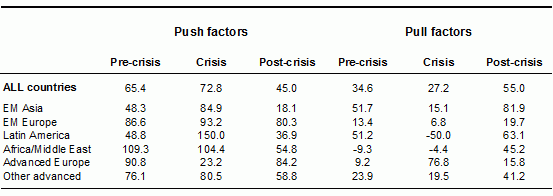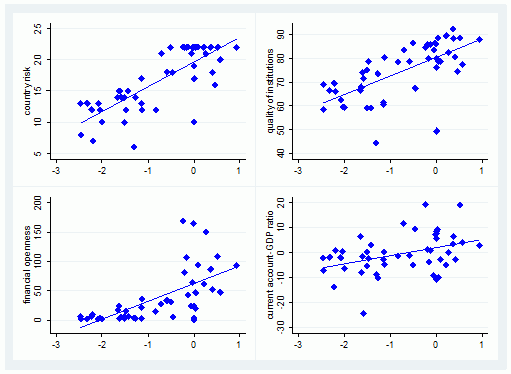The global economy has witnessed massive fluctuations in capital flows since 2005. While the 2007-08 global financial crisis triggered strong portfolio capital flows in particular into bonds of some advanced economies, the 2009-11 period of recovery in emerging market economies (EMs) and the sovereign debt woes in some advanced economies has been marked by a surge in capital flows to EMs. Yet what has been striking about these two episodes is not only their global reach, but also the high degree of heterogeneity in capital flows, both across advanced economies and across emerging market economies.
The question of what explains capital flow dynamics in the 2007-08 crisis and in 2009-11 remains highly controversial. Some have stressed the importance of “push” factors, in particular monetary and fiscal policies in advanced economies, as the main culprits behind this surge in capital flows. In contrast, others have emphasised “pull” factors, such as real divergences between EMs and advanced economies, as the main driver of the current pattern of capital flows. In fact, this controversy has become one of the core issues of debate in international fora such as the G20, which is considering a code of conduct for capital flow management, including the imposition of capital controls to deal with volatile capital flows.
The debate on the drivers of global capital flows stretches back at least to the 1990s when many EMs liberalised their capital accounts and started attracting substantial portfolio capital inflows (Calvo, Leiderman, and Reinhart 1996). A revival of interest in large swings in global capital flows occurred with the 2007-08 financial crisis, with much of the evidence stressing the disruptive effects of such swings during periods of financial stress, such as through sudden stops, surges, retrenchments, and capital flight (Reinhart and Reinhart 2009; Cardarelli, Elekdag and Kose 2009; Forbes and Warnock 2011).
Given the importance of the debate about the role of push factors versus pull factors as drivers of capital, a recent study (Fratzscher 2011) focuses on two questions. First, how important have been common global shocks (such as shocks to global risk and liquidity, as well as to global asset prices) for capital flows? And second, how relevant have been macroeconomic policies, institutions and financial policies in helping countries shield themselves from the effect of such global shocks on capital flows? The first question is informative about the role of push factors, while the second allows gauging the relevance of pull factors. The study’s focus is on high-frequency (weekly) portfolio investment flows at the micro level, ie at the level of individual investment funds, across a broad geographic coverage of 50 countries worldwide, allowing for a clean identification of the drivers of capital flows.
Push factors vs. pull factors: Empirical evidence
Table 1 quantifies and compares the relative importance of common shocks (push factors) and country-specific determinants (pull factors) based on the findings of this study. The table shows the percentage share of portfolio flows to 50 countries, averaged across the six country groups/regions shown, explained by push factors (common/global shocks to risk, liquidity, and asset prices) versus pull factors (country-specific shocks, institutional quality, country risk rating, and macroeconomic fundamentals).
Table 1. The role of push factors versus pull factors for global capital flows (% of capital flows explained)
Source: Fratzscher (2011). The three periods are defined as follows: pre-crisis period (1 May 2005 to 7 Aug 2007); crisis (8 Aug 2007 to 15 March 2009); post-crisis (16 March 2009 to 31 October 2010). Note that negative figures in the table indicate that a set of factors, ceteris paribus, predicted capital inflows due to pull factors for some countries whereas these countries actually experienced net capital outflows due to the dominance of push factors.
The findings indicate that push factors were more important overall as a driver of net capital flows for many countries in the pre-crisis period of 2005-07—accounting for about 65%, on average across all 50 countries, of capital flows—and during the 2007-08 financial crisis, explaining about 73% of the variance. A disaggregated picture of the different common shocks is consistent with the hypothesis that the dynamics of capital flows was in fact primarily driven by safe-haven flows (towards the US and other advanced economies, as well as from equities into bonds) during the crisis.
However, in the period since March 2009, push factors appear to have become less important as drivers of global capital flows, whereas it is country-specific pull factors that have come to dominate in explaining capital flows—the latter explaining 55% on average across the 50 economies. Moreover, pull factors have been particularly dominant for countries in Emerging Asia and in Latin America, accounting for 82% and 63%, respectively, of the variance in net capital flows to these two regions since 2009.
Which country-specific pull factors matter?
Which are the country-specific pull factors that have been behind this pattern of capital flows? The findings of the study indicate that it has been the institutional quality, country risk together with the strength of macroeconomic fundamentals and policies, that explains a large share of the dynamics of capital flows during and after the 2007-08 crisis. By contrast, countries’ external (real and financial) exposure appears to have largely been irrelevant for understanding the global capital flow dynamics, including the retrenchment of capital during the crisis, in particular for emerging economies.
Figure 1 illustrates this point. It shows on the horizontal axis the response of portfolio capital flows to key crisis events for each of the 50 countries in the sample, while the vertical axis provides the values of the four respective determinants—country risk, the quality of political institutions (a higher value for both indicating lower risk or better institutions), financial openness and the current account to GDP ratio—for each of the countries. The figures show a strikingly strong correlation pattern. Specifically, countries with a high sovereign rating and with a good quality of policy institutions experience much smaller sensitivity of their net capital flows to adverse crisis events.
Figure 1. Determinants of effect of crisis events on capital flows
Source: Fratzscher (2011).
Putting these findings into perspective, it should be highlighted that the period since 2005 has been in many ways extraordinary for the dynamics of global capital flows, as a period of a sharp contraction of capital flows, in particular to some EMs, during the 2007-08 crisis was followed by an equally extraordinary surge in capital flows to EMs. Hence an important open issue is whether the current dynamics of global capital flows will continue well into the future, and what it implies for the risk of sudden stops and capital flow reversals with all its adverse implications for global growth and financial stability. But in particular because it is so important to understand better the dynamics and risks of periods of financial stress, these findings may be instructive about how future crisis or corrections may play out.
Policy implications
The findings have a number of implications for economic policy.
- On one hand, financial globalisation and the exposure to common global factors have made countries more vulnerable to external and global shocks.
- On the other hand, the exposure to domestic risks has also been a relevant factor during the crisis and thereafter, in particular those domestic risks related to poor macroeconomic fundamentals, policies and institutions.
This implies that countries are far from innocent bystanders that are powerless in being exposed to volatile global markets, and that indeed they have tools to insulate to some extent their economies from adverse global shocks.
These findings have a bearing in particular on the current debate on how EMs should deal with volatile capital flows.
- To the extent that capital flows are driven by global factors, some EM policymakers have argued that this would justify the use of capital controls as well as policy interventions, eg in foreign-exchange markets.
- Such policies may be misguided if the drivers of capital flows are mainly found at home.
When idiosyncratic, EM-specific policies and conditions are driving the flows, the response should be for policymakers to focus on making their domestic economies more resilient by improving institutions, deepening financial markets and enhancing macroeconomic and prudential policies.
References
Calvo, Guillermo, Leonardo Leiderman, and Carmen Reinhart. (1996). “Inflows of Capital to Developing Countries in the 1990s.” Journal of Economic Perspectives 10(2): 123-139.
Cardarelli, Roberto, Selim Elekdag and M.Ayhan Kose. (2009). “Capital Inflows: Macroeconomic Implications and Policy Responses.” IMF Working Paper WP/09/40.
Forbes, Kristin and Frank Warnock, (2011). Capital Flow Waves: Surges, Stops, Flight and Retrenchment, mimeo, MIT and University of Virginia.
Fratzscher, Marcel, (2011). “Capital Flows, Push versus Pull Factors and the Global Financial Crisis”, ECB Working Paper 1364.
Hau, Harald and Helene Rey (2006), "Exchange Rate, Equity Prices and Capital Flows," Review of Financial Studies, 19 (1), pp. 273-317.
Reinhart, Carmen and Vincent Reinhart. (2009). “Capital Flow Bonanzas: An Encompassing View of the Past and Present,” in Jeffrey Frankel and Francesco Giavazzi, eds. NBER International Seminar in Macroeconomics 2008. Chicago: Chicago University Press.




